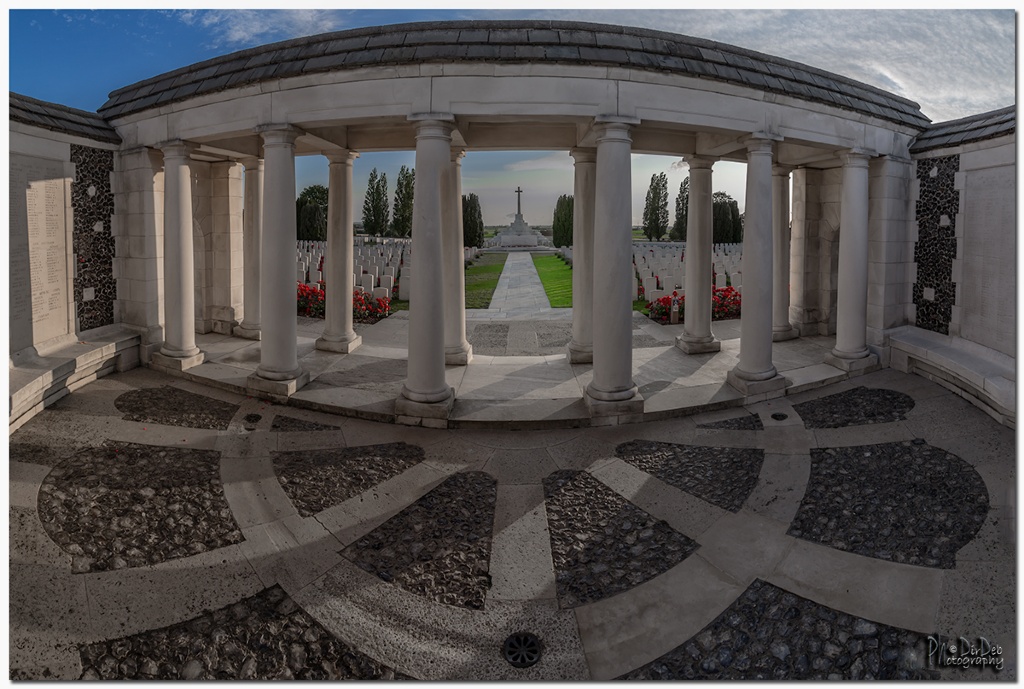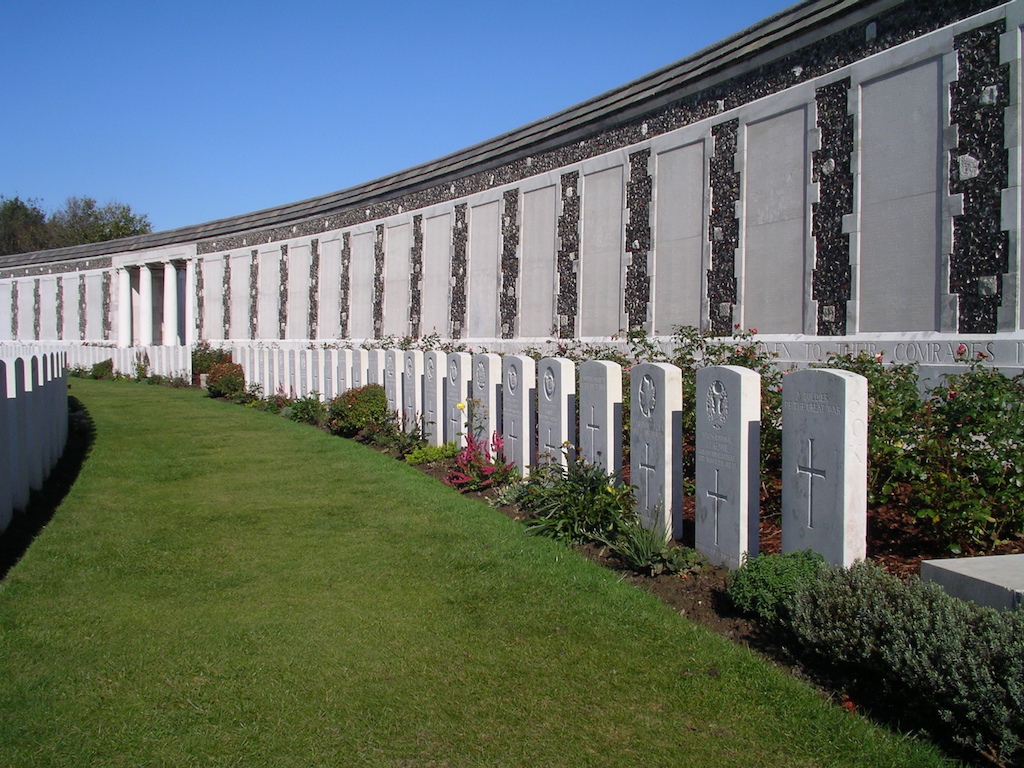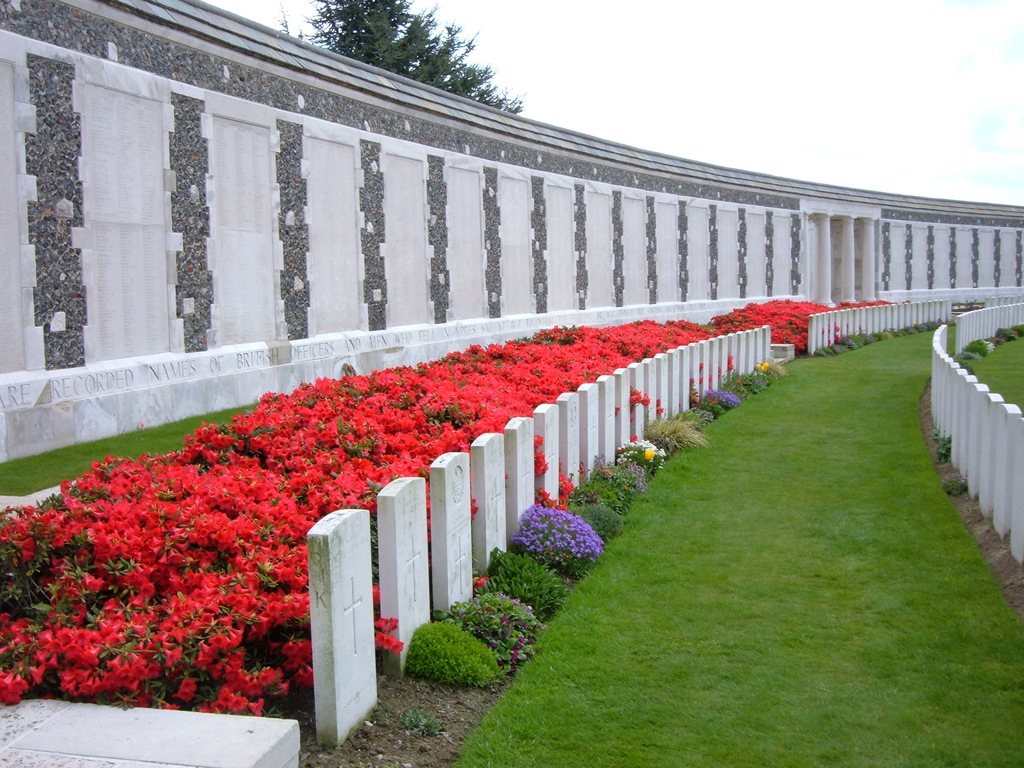Tyne Cot Memorial
- Country Belgium
- Total identified casualties 34970 Find these casualties
- Region West-Vlaanderen
- Identified casualties from First World War
- GPS Coordinates Latitude: 50.88745, Longitude: 3.00051
Location information
The Tyne Cot Memorial to the Missing forms the north-eastern boundary of Tyne Cot Cemetery, which is located 9 kilometres north east of Ieper town centre, on the Tynecotstraat, a road leading from the Zonnebeekseweg (N332).
The names of those from United Kingdom units are inscribed on Panels arranged by Regiment under their respective Ranks.
The names of those from New Zealand units are inscribed on panels within the New Zealand Memorial Apse located at the centre of the Memorial.
Visiting information
There are two separate registers for this site - one for the cemetery and one for the memorial. The cemetery register will be found in the gatehouse as you enter the cemetery, and the memorial register will be found in the left hand rotunda of the memorial as you face the memorial. SCHOOL GROUPS: TEACHERS - PLEASE CLOSELY SUPERVISE YOUR STUDENTS, PARTICULARLY AT THE TYNE COT CEMETERY CROSS OF SACRIFICE Wheelchair access to this cemetery is possible via an entrance at the rear and is signposted from the car park. For further information regarding wheelchair access, please contact our Enquiries Section on 01628 507200.
Panel Numbers quoted at the end of each entry relate to the panels dedicated to the Regiment with which the casualty served. In some instances, where a casualty is recorded as attached to another Regiment, his name may appear within their Regimental Panels. Please refer to the on-site Memorial Register Introduction. The Addenda Panel lists those service personnel whose details are awaiting addition to the Regimental Panels.
Wheelchair access to this cemetery is possible via an entrance at the rear and is signposted from the car park.
For further information regarding wheelchair access, please contact our Enquiries Section on 01628 507200.
History information
The Tyne Cot Memorial is one of four memorials to the missing in Belgian Flanders which cover the area known as the Ypres Salient. Broadly speaking, the Salient stretched from Langemarck in the north to the northern edge in Ploegsteert Wood in the south, but it varied in area and shape throughout the war.
The Salient was formed during the First Battle of Ypres in October and November 1914, when a small British Expeditionary Force succeeded in securing the town before the onset of winter, pushing the German forces back to the Passchendaele Ridge. The Second Battle of Ypres began in April 1915 when the Germans released poison gas into the Allied lines north of Ypres. This was the first time gas had been used by either side and the violence of the attack forced an Allied withdrawal and a shortening of the line of defence.
There was little more significant activity on this front until 1917, when in the Third Battle of Ypres an offensive was mounted by Commonwealth forces to divert German attention from a weakened French front further south. The initial attempt in June to dislodge the Germans from the Messines Ridge was a complete success, but the main assault north-eastward, which began at the end of July, quickly became a dogged struggle against determined opposition and the rapidly deteriorating weather. The campaign finally came to a close in November with the capture of Passchendaele.
The German offensive of March 1918 met with some initial success, but was eventually checked and repulsed in a combined effort by the Allies in September.
The battles of the Ypres Salient claimed many lives on both sides and it quickly became clear that the commemoration of members of the Commonwealth forces with no known grave would have to be divided between several different sites.
The site of the Menin Gate was chosen because of the hundreds of thousands of men who passed through it on their way to the battlefields. It commemorates those of all Commonwealth nations, except New Zealand, who died in the Salient, in the case of United Kingdom casualties before 16 August 1917 (with some exceptions). Those United Kingdom and New Zealand servicemen who died after that date are named on the memorial at Tyne Cot, a site which marks the furthest point reached by Commonwealth forces in Belgium until nearly the end of the war. Other New Zealand casualties are commemorated on memorials at Buttes New British Cemetery and Messines Ridge British Cemetery.
The TYNE COT MEMORIAL now bears the names of almost 35,000 officers and men whose graves are not known. The memorial, designed by Sir Herbert Baker with sculpture by Joseph Armitage and F.V. Blundstone, was unveiled by Sir Gilbert Dyett on 20 June 1927.
The memorial forms the north-eastern boundary of TYNE COT CEMETERY, which was established around a captured German blockhouse or pill-box used as an advanced dressing station. The original battlefield cemetery of 343 graves was greatly enlarged after the Armistice when remains were brought in from the battlefields of Passchendaele and Langemarck, and from a few small burial grounds. It is now the largest Commonwealth war cemetery in the world in terms of burials. At the suggestion of King George V, who visited the cemetery in 1922, the Cross of Sacrifice was placed on the original large pill-box. There are three other pill-boxes in the cemetery.
There are now 11,961 Commonwealth servicemen of the First World War buried or commemorated in Tyne Cot Cemetery, 8,373 of these are unidentified.
The cemetery was designed by Sir Herbert Baker.






